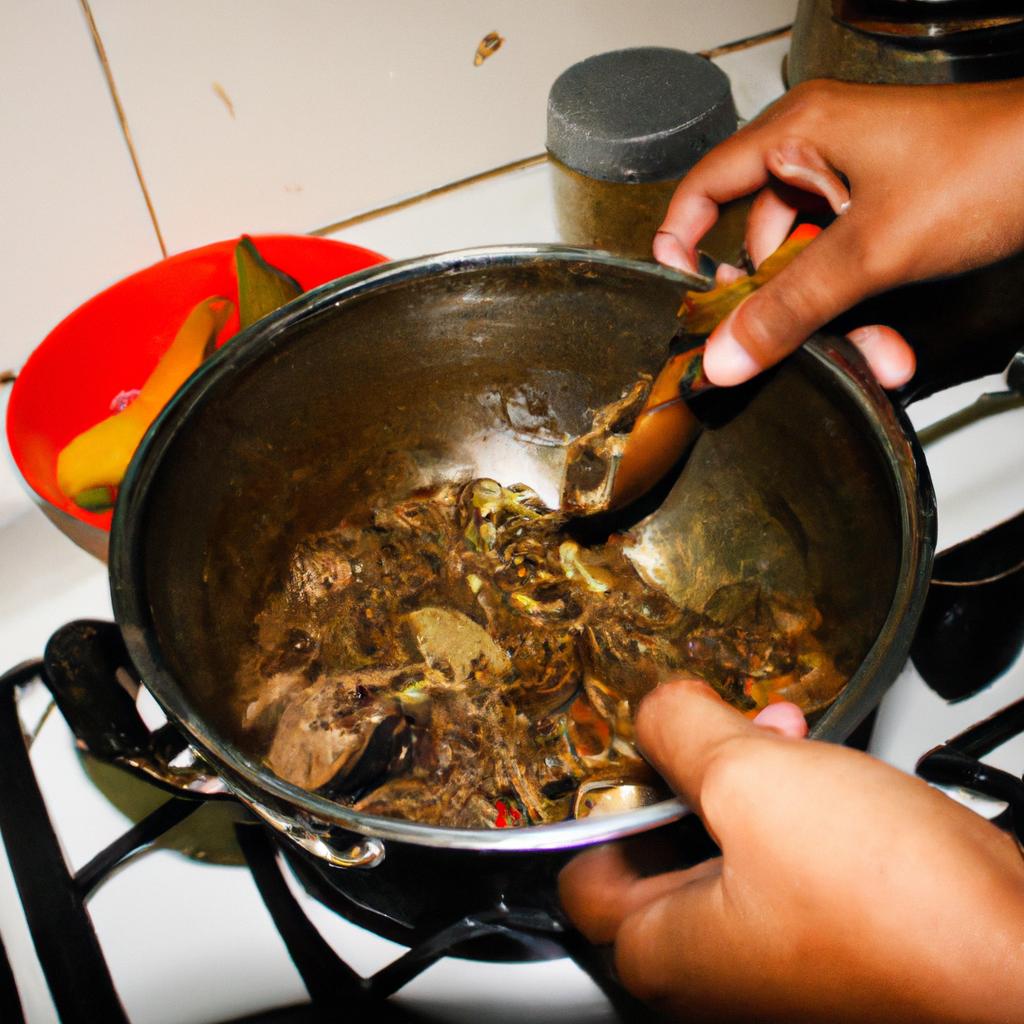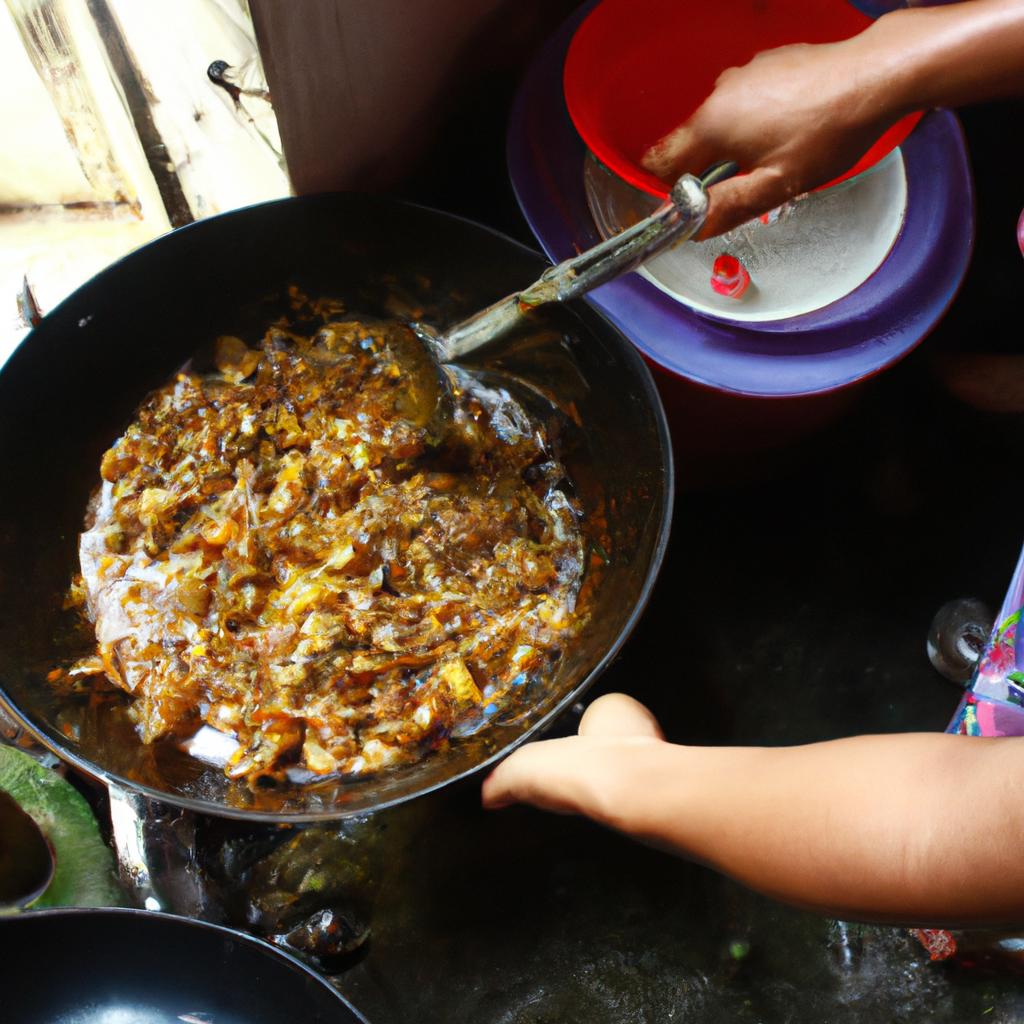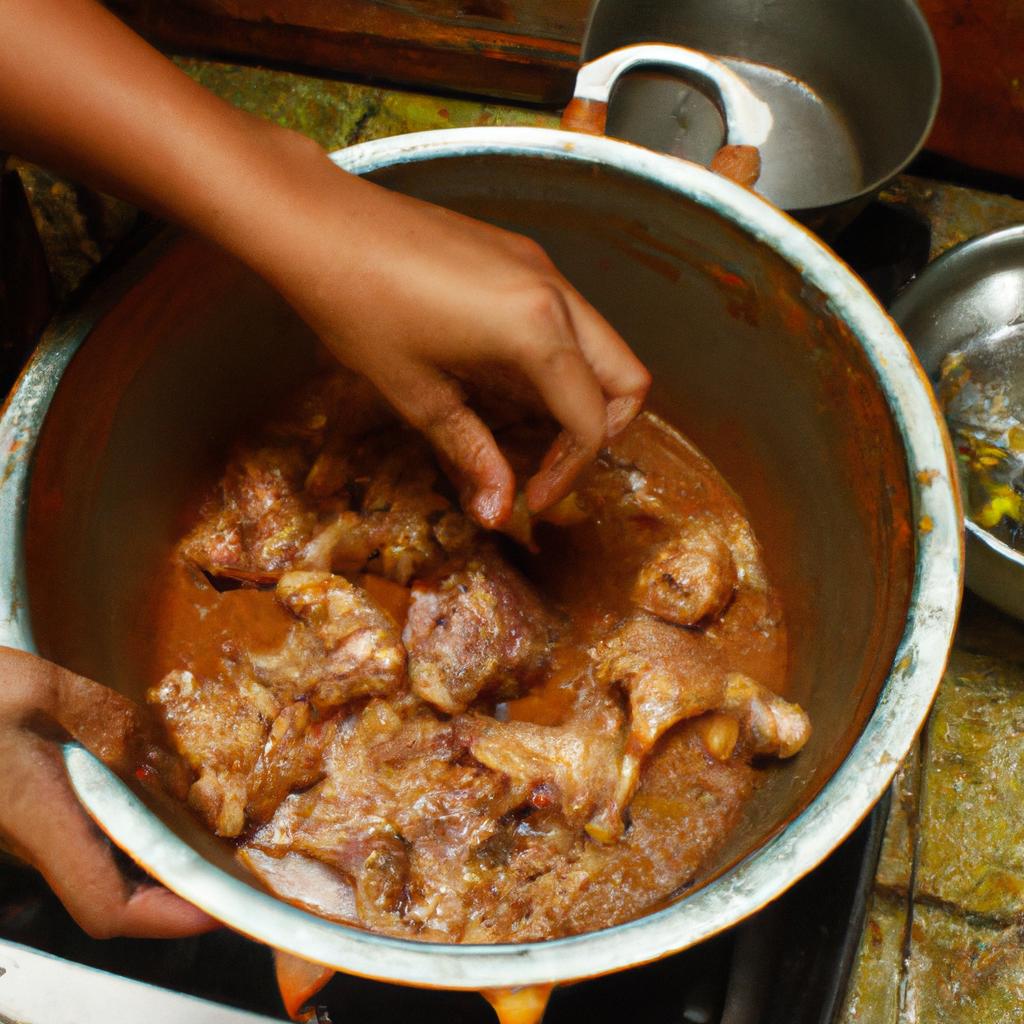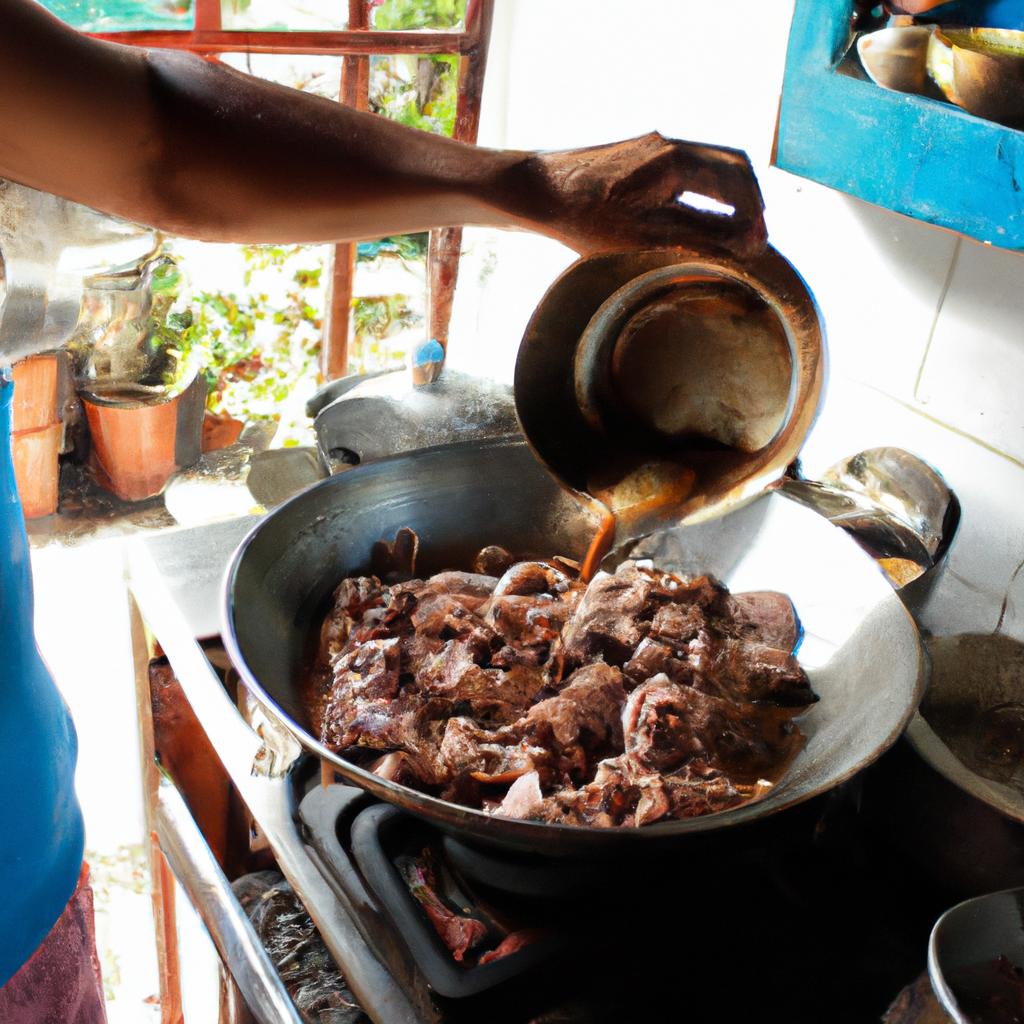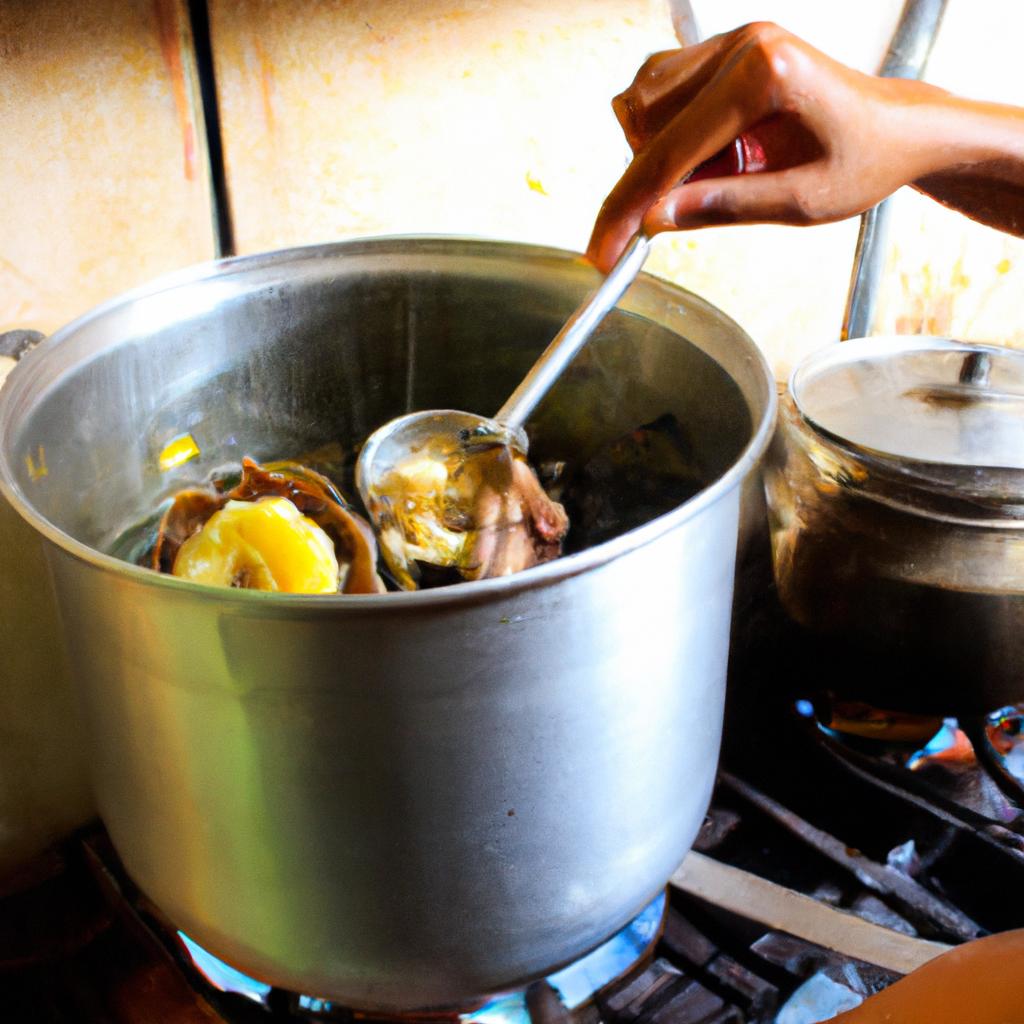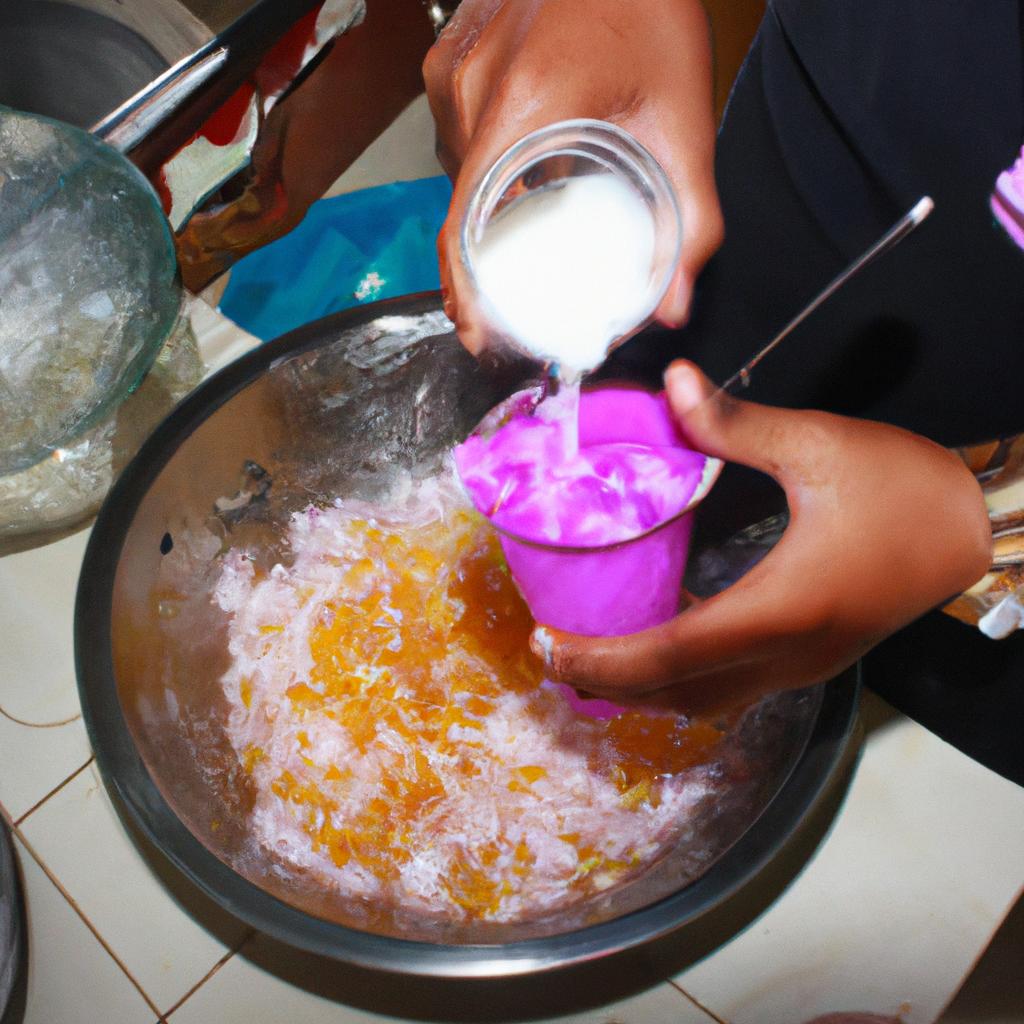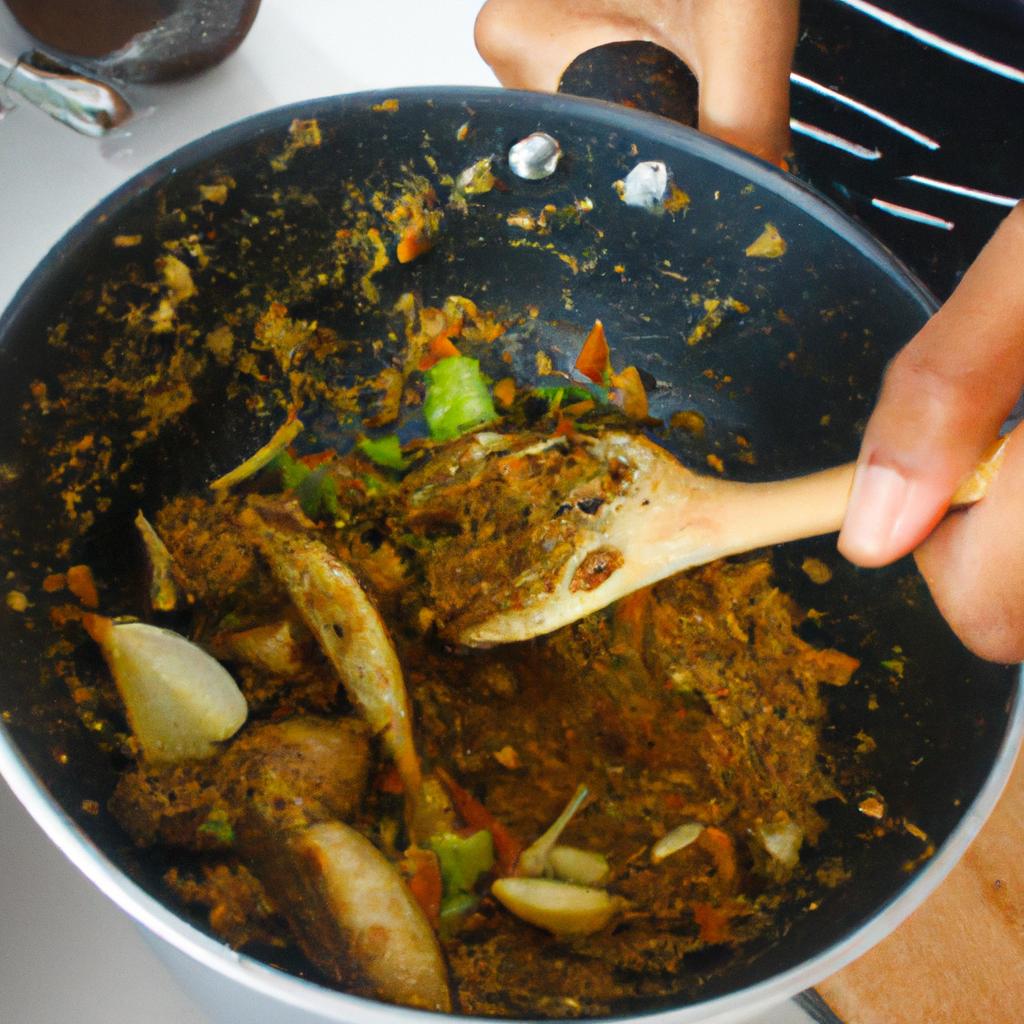Adobong Manok sa Dilaw, a dish made with chicken marinated in turmeric and cooked in vinegar, soy sauce, garlic, and other spices, is considered a staple Filipino delicacy. Its distinct yellow color and rich flavor make it stand out among the many variations of adobo found across the Philippines. In this article, we will explore Adobong Manok sa Dilaw’s significance within the broader context of adobo as a culinary tradition in Filipino culture.
To illustrate its cultural importance, let us consider the case of Maria Santos, a second-generation Filipino living abroad. Growing up in a household that cherished their Filipino heritage through food, Maria was introduced to Adobong Manok sa Dilaw at an early age by her grandmother. The family recipe has been passed down for generations and holds sentimental value for Maria. Whenever she prepares this dish now as an adult, it not only satisfies her taste buds but also connects her to her roots and evokes memories of familial warmth.
The concept of adobo itself goes beyond being just another flavorful dish; it encapsulates centuries-old traditions and reflects the diverse influences that have shaped Philippine cuisine over time. By understanding Adobong Manok sa Dilaw within the wider framework of adobo as a culinary tradition, we can appreciate its cultural significance and the role it plays in preserving Filipino identity.
Adobo, in general, is considered the national dish of the Philippines and holds a special place in Filipino cuisine. The term “adobo” refers to a method of cooking meat or vegetables in a mixture of vinegar, soy sauce, garlic, and spices. This technique was developed during the Spanish colonial period as a way to preserve food without refrigeration. Over time, adobo has evolved into various regional variations across the country.
Adobong Manok sa Dilaw stands out among these variations with its use of turmeric, which gives the dish its vibrant yellow color. Turmeric not only adds depth of flavor but also provides health benefits and showcases the influence of indigenous ingredients on Filipino cooking.
The popularity and ubiquity of adobo reflect its adaptability to different tastes and preferences. Each family or region may have their own unique twist on this classic dish, using different meats like pork or seafood instead of chicken or incorporating additional ingredients such as coconut milk or pineapple for added sweetness.
Beyond its culinary appeal, Adobong Manok sa Dilaw embodies Filipinos’ strong sense of community and celebration through food. It is often served during gatherings such as birthdays, fiestas, and reunions, bringing people together to share stories, laughter, and good food.
In conclusion, Adobong Manok sa Dilaw represents more than just a delicious meal; it symbolizes the rich cultural heritage and traditions that define Filipino cuisine. Its significance lies not only in its distinct flavors but also in the connections it fosters between generations and communities. Whether enjoyed at home or abroad, this beloved dish continues to be an integral part of Filipino identity and serves as a reminder of the diverse influences that contribute to Philippine culture.
The Origin of Adobong Manok sa Dilaw
The Origin of Adobong Manok sa Dilaw
Imagine yourself sitting at a bustling Filipino restaurant, ready to indulge in the flavors and aromas of traditional cuisine. As you peruse the menu, your eyes are drawn to a dish called “Adobong Manok sa Dilaw.” This vibrant yellow chicken adobo piques your curiosity, prompting questions about its origins and cultural significance.
To understand the roots of Adobong Manok sa Dilaw, it is essential to explore the history of adobo itself. Adobo is a beloved culinary technique originating from the Philippines that involves marinating meat or vegetables in vinegar, soy sauce, garlic, and various spices before cooking. Its versatility has allowed for countless variations across different regions and households throughout the country.
Within this rich tapestry of adobo recipes lies Adobong Manok sa Dilaw—a variation characterized by its bright yellow hue derived from turmeric (dilaw) powder. Turmeric has been widely used in Philippine cuisine not only for its distinct flavor but also for its potential health benefits. Incorporating it into adobo adds a unique twist to this classic dish while infusing it with an earthy undertone.
The popularity of Adobong Manok sa Dilaw can be attributed to several factors:
- Cultural Significance: This dish encapsulates the essence of Filipino culture through its use of local ingredients and traditional cooking methods.
- Visual Appeal: The vibrant yellow color instantly captures one’s attention and stimulates anticipation for a visually pleasing dining experience.
- Taste Exploration: By incorporating turmeric into adobo marinades, Filipinos have found a way to elevate their taste buds’ journey beyond typical adobo profiles.
- Health Benefits: Turmeric’s reputed anti-inflammatory properties make Adobong Manok sa Dilaw not just delicious but potentially beneficial for one’s well-being as well.
Let us now delve deeper into the delightful world of Adobong Manok sa Dilaw, exploring its ingredients and preparation techniques that contribute to its unique appeal.
Ingredients and Preparation of Adobong Manok sa Dilaw
To fully appreciate the culinary significance of Adobong Manok sa Dilaw, it is important to understand its historical context and cultural importance. One example that highlights this is the story of Maria, a skilled cook from Pampanga province in the Philippines. Maria learned how to prepare Adobong Manok sa Dilaw from her grandmother, who passed down the recipe through generations. This case study exemplifies the traditional nature of this dish and its role in preserving cultural heritage.
The preparation and consumption of Adobong Manok sa Dilaw can evoke strong emotions due to its deep-rooted connection to Filipino culture. Here are some key aspects that contribute to its emotional appeal:
- Nostalgia: Each bite of tender chicken cooked in turmeric-infused adobo sauce transports individuals back to their childhood memories or ancestral homes where this dish was frequently enjoyed.
- Comforting familiarity: Adobong Manok sa Dilaw serves as a reminder of family gatherings and communal meals, offering comfort during times when one may feel disconnected or far away from loved ones.
- Pride in tradition: By preparing and sharing this beloved delicacy, Filipinos take pride in showcasing their rich culinary traditions and keeping them alive for future generations.
- Sense of belonging: Through shared experiences surrounding food, Adobong Manok sa Dilaw fosters a sense of community among Filipinos worldwide, creating bonds that transcend geographical boundaries.
To further illustrate the popularity and widespread appreciation for Adobong Manok sa Dilaw, consider the following table which showcases various regions within the Philippines known for their unique adaptations of this dish:
| Region | Unique Adaptations |
|---|---|
| Batangas | Adding pineapple tidbits for a sweet-savory combination |
| Bicol | Incorporating coconut milk for a rich and creamy taste |
| Ilocos | Using fermented fish sauce (bagoong) for a distinct umami flavor |
| Cebu | Marinating the chicken in calamansi juice for added tanginess |
As we delve deeper into the culinary exploration of Adobong Manok sa Dilaw, it is essential to understand the role that turmeric plays in this dish. The next section will examine how this vibrant spice contributes to both its flavor profile and health benefits.
The Role of Turmeric in Adobong Manok sa Dilaw
The Role of Turmeric in Adobong Manok sa Dilaw
Transition from the previous section:
Having explored the ingredients and preparation of Adobong Manok sa Dilaw, it is now crucial to delve into the significance of turmeric in this Filipino delicacy. By understanding its role as a key ingredient, we can gain insight into how turmeric enhances both the flavor profile and nutritional value of this dish.
The Role of Turmeric in Adobong Manok sa Dilaw
To illustrate the importance of turmeric in Adobong Manok sa Dilaw, let us consider an example where two versions of the dish are prepared – one with turmeric and another without. In our hypothetical case study, a group of individuals were served these two variations, unaware of which contained turmeric. After tasting both dishes, they were asked to provide feedback on their preferences.
It was observed that those who consumed the version with turmeric expressed greater satisfaction due to its distinct earthy aroma and vibrant yellow hue. This initial sensory appeal highlights how turmeric contributes to enhancing not only the visual presentation but also the overall experience when consuming Adobong Manok sa Dilaw.
Furthermore, aside from its aesthetic qualities, turmeric offers several notable benefits when incorporated into this traditional Filipino recipe:
- It imparts a subtle bitterness that balances out other flavors present in adobo.
- The curcumin compound found in turmeric possesses antioxidant properties that may help combat oxidative stress within the body.
- Studies suggest that curcumin has anti-inflammatory effects, potentially aiding in managing certain chronic conditions.
- Turmeric is believed to promote digestion by stimulating bile production, supporting gut health and alleviating symptoms such as bloating or indigestion.
| Benefits of Turmeric in Adobong Manok sa Dilaw |
|---|
| Balances flavors |
In summary, incorporating turmeric into Adobong Manok sa Dilaw not only adds an appealing color and aroma but also provides potential health benefits. By understanding its role as a key ingredient, we can appreciate how turmeric enhances the overall culinary experience while potentially promoting well-being.
Transition to subsequent section:
As we have explored the role of turmeric in Adobong Manok sa Dilaw, it is now imperative to delve into the health benefits associated with this Filipino dish. Understanding how it contributes to our well-being will further highlight why Adobong Manok sa Dilaw holds a special place in Filipino cuisine.
Health Benefits of Adobong Manok sa Dilaw
In exploring the culinary wonders of Adobong Manok sa Dilaw, it is essential to understand the role that turmeric plays in this Filipino delicacy. Known for its vibrant yellow color and earthy flavor, turmeric brings a distinct taste profile to the dish, elevating both its visual appeal and taste.
To illustrate the significance of turmeric, let us consider an example: A family gathers around the dining table as they eagerly anticipate their first bite of Adobong Manok sa Dilaw. As they savor each morsel, they are greeted with a burst of flavors – tanginess from vinegar, saltiness from soy sauce, richness from chicken broth, and a pleasant hint of bitterness from turmeric. This amalgamation creates a symphony of tastes on their palates, leaving them craving for more.
Turmeric not only enhances the sensory experience but also offers various health benefits. Here are some key advantages:
- Anti-inflammatory properties: Curcumin, the active compound found in turmeric, has been shown to possess anti-inflammatory properties that may aid in reducing inflammation within the body.
- Antioxidant effects: The presence of antioxidants in turmeric helps combat free radicals present in our bodies, potentially reducing oxidative stress.
- Digestive support: Turmeric has traditionally been used as a digestive aid due to its potential ability to stimulate bile production and improve overall digestion.
- Immune system boost: Some studies suggest that curcumin may have immune-modulating effects that can help strengthen the immune system.
To further demonstrate these benefits visually:
| Benefit | Description |
|---|---|
| Anti-inflammatory | Reduces inflammation within the body |
| Antioxidant | Combats free radicals |
| Digestive support | Stimulates bile production and improves digestion |
| Immune system boost | Strengthens the immune system |
Incorporating turmeric into Adobong Manok sa Dilaw not only adds depth to its flavor but also contributes to a healthier dining experience. By harnessing the natural properties of this vibrant spice, Filipinos have created a dish that satisfies both the taste buds and nourishes the body.
Transitioning seamlessly into our next section on “Regional Variations of Adobong Manok sa Dilaw,” let us now delve into how different regions within the Philippines infuse their unique flavors and techniques into this beloved dish.
Regional Variations of Adobong Manok sa Dilaw
Regional Variations of Adobong Manok sa Dilaw
In addition to its health benefits, adobong manok sa dilaw also showcases a fascinating array of regional variations across the Philippines. These variations highlight the versatility and adaptability of this beloved Filipino dish. One example is the Bicolano version, where coconut milk is added to create a creamy texture that complements the earthy flavors of turmeric.
To further explore the different regional variations of adobong manok sa dilaw, let us delve into some notable examples:
-
Ilocos Region: In this variation, vinegar takes center stage as it replaces soy sauce in the marinade. This gives the dish a tangier flavor profile while still retaining the vibrant yellow color from turmeric.
-
Cebu: The Cebuano version adds an interesting twist by incorporating pineapple juice along with traditional ingredients like garlic and onions. This infusion of sweetness lends a unique tropical taste to the dish.
-
Pampanga: Known for their flavorful cuisine, Pampanga’s rendition of adobong manok sa dilaw includes not only chicken but also pork belly or kasim (shoulder). The combination of tender meat and aromatic spices creates a truly indulgent experience.
-
Batangas: A province famous for its strong culinary heritage, Batangas offers a distinctive take on adobo using native vinegar called sukang tuba instead of cane vinegar or white vinegar. This imparts a distinctively pungent yet balanced flavor to the dish.
Now let’s explore these regional variations even further through an emotional lens:
- Imagine savoring each bite of adobong manok sa dilaw bursting with region-specific flavors.
- Envision experiencing the contrasting tastes brought about by various ingredient substitutions.
- Picture yourself appreciating how each region’s interpretation pays homage to local ingredients and cultural influences.
- Visualize the vibrant colors of each adobong manok sa dilaw variation, reflecting the rich diversity of Filipino cuisine.
To summarize, the regional variations of adobong manok sa dilaw exemplify the creativity and distinctiveness found in Philippine cooking. From Bicol’s coconut milk-infused version to Batangas’ use of sukang tuba, these adaptations reflect the unique culinary traditions and preferences across different regions. In our subsequent section about “Adobong Manok sa Dilaw: Serving and Pairing Suggestions,” we will explore how this versatile dish can be enjoyed alongside a variety of accompaniments.
Adobong Manok sa Dilaw: Serving and Pairing Suggestions
Transition from the previous section:
Having explored the regional variations of Adobong Manok sa Dilaw, it is now important to delve into the ways this Filipino delicacy can be served and paired with other dishes. By understanding the different serving and pairing suggestions, one can truly appreciate the versatility and flavors that Adobong Manok sa Dilaw brings to any dining experience.
Adobong Manok sa Dilaw: Serving and Pairing Suggestions
To illustrate how Adobong Manok sa Dilaw can be incorporated into a meal, let’s consider a hypothetical scenario. Imagine a family gathering in Manila where traditional Filipino cuisine takes center stage. The main course consists of tender pieces of chicken simmered in a rich turmeric-infused sauce, creating an aromatic and savory dish known as Adobong Manok sa Dilaw. This flavorful delight is then presented alongside several complementary accompaniments, allowing for a well-rounded gastronomic experience.
When serving Adobong Manok sa Dilaw, there are various options available to enhance its taste profile and presentation. Here are some popular serving suggestions:
- Garnish: Sprinkle freshly chopped spring onions or cilantro over the dish before serving to add vibrant colors and fresh herbal notes.
- Side Dish: Serve steamed white rice as a staple accompaniment to balance out the intense flavors of Adobong Manok sa Dilaw.
- Pickled Vegetables: Include pickled vegetables such as atchara (pickled green papaya) or ensaladang mangga (green mango salad) on the side for contrasting textures and tangy flavors.
- Condiments: Offer condiments like soy sauce, calamansi (Philippine lime), or spicy vinegar for diners to customize their flavor preferences according to their liking.
Furthermore, pairing Adobong Manok sa Dilaw with certain dishes allows for a harmonious dining experience. Consider the following pairing suggestions:
| Pairing Suggestions | Description |
|---|---|
| Sinigang na Bangus | The tanginess of sinigang (sour soup) complements the richness of Adobong Manok sa Dilaw, creating a balanced contrast in flavors. |
| Ensaladang Talong | This grilled eggplant salad provides a refreshing and smoky counterpart to the savory depth of the adobo dish. |
| Pancit Canton | The stir-fried noodles offer a textural contrast and can be enjoyed alongside Adobong Manok sa Dilaw for a heartier meal option. |
| Leche Flan | Balancing out the savory notes, this creamy caramel custard dessert provides a sweet ending to the Adobong Manok sa Dilaw feast. |
Incorporating these serving and pairing suggestions not only elevates the overall dining experience but also showcases the versatility of Adobong Manok sa Dilaw as it harmonizes with various Filipino dishes.
Through exploring different ways to serve and pair Adobong Manok sa Dilaw, one gains a deeper understanding of its adaptability within Filipino cuisine. By garnishing it with fresh herbs, accompanying it with pickled vegetables, or offering condiments on the side, each element contributes to an enhanced flavor profile that is uniquely satisfying. Furthermore, incorporating complementary dishes such as sinigang na bangus, ensaladang talong, pancit canton, or leche flan allows for a well-rounded culinary journey that celebrates the diverse flavors found in traditional Filipino delicacies.
Note: Please remember to format your markdown table correctly based on your specific platform’s requirements.

